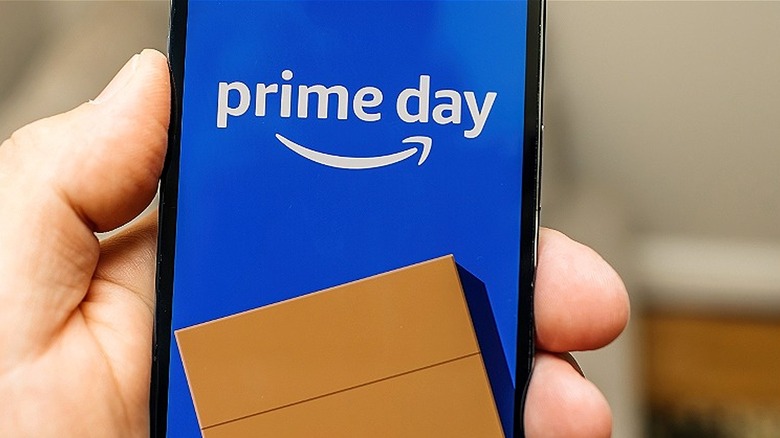The Surprising Amount Americans Spend On Prime Day Each Year
Whether you're a die-hard fan or simply have started to see preemptive ads, you probably know that Amazon Prime Day is coming up soon. In 2024, Prime Day happens on July 16-17 and will continue to offer consumers (who are Prime members) the chance to shop for special deals on everything from appliances to electronics to health and beauty products. The event is increasingly part of the perks that can make Amazon Prime worth it. Dubbed Black Friday in July, Prime Day has also increasingly become a massive money maker for both Amazon and small business alike. In fact, according to a Capital One Shopping Research report, sales from Amazon's 2023 Prime Day event totaled $12.9 billion.
While revenue growth for Prime Day still hasn't returned to pre-pandemic levels, it's worth noting that Prime Day revenue accounts for 2.24% of Amazon's total annual global revenue. So, chances are good this summer sale will continue for many years to come. In 2023, consumers across 24 different countries purchased over a whopping 375 million items during the Prime Day event. Meanwhile, the average consumer order was $58.67 while the average household spend was $181.72.
Total spending for 2023's Prime Day was up 6.7% over 2022, but per-consumer spending actually decreased 3.4%. Despite this, Amazon's Prime Day still maintains its foothold as one of the biggest online shopping days in the country. Plus, Prime Day has forever changed the traditional summer retail calendar, especially for back-to-school shoppers.
What to know about Prime Day
You might be surprised to learn that Prime Day was originally conceived as a one-time-only event. The summer sale was initially meant to serve as a celebration for Amazon's 20th anniversary as a company in 2015. However, it was so successful Amazon elected to continue the tradition, offering a version of the sale every year since, even expanding the event to two days in 2017. Amazon's Prime Day is available exclusively to Amazon Prime members, so if you're not already a member it could be a deciding factor for those looking to get more immediate perks out of their membership. A Prime membership is $139 annually, or $14.99 per month if you prefer a smaller monthly payment option. It can be hard to know if an Amazon Prime membership is actually worth it, so making sure to do your research on the perks of the program is key before signing up.
Once Prime Day has begun, consumers have 48 hours to shop discounts and special lightning deals on a wide range of potential items across price points. For instance, the top three bestselling items for 2023's Prime Day were Amazon Fire Sticks, Temptations Classic Cat Food, and the Echo Dot. It's also worth mentioning that Prime Day doesn't necessarily have to cost you a lot, especially if you're shopping for everyday items. The average cost per item sold on Prime Day in 2023 was just $31.21 with 71% of all Prime Day purchases coming in under $50.
Is Amazon's Prime Day worth it?
The value of any shopping sale comes down to the specific items you're most looking for. If you're particularly interested in Amazon-specific products, like Ring doorbells, Kindles, or Fire TV devices, then chances are good Prime Day will have a deal that appeals to you. In fact, 62.8% of purchases made during Prime Day 2022 were Amazon-brand products. Yet, while Prime Day is often dubbed "Black Friday in July", it's important to realize that the deals available don't apply to all brands and retailers the way they typically do on Black Friday. It's also worth mentioning that if you're looking for items such as clothing, major appliances, or furniture, Prime Day probably isn't your best bet.
With that being said, Capital One reports that for Prime Day 2023, although Amazon advertised discounts as low as 80% off, the average discount for consumers on Amazon Prime Day was 16.2% (on that note, beware of the sneaky ways Amazon can trick you into spending). This means that the total event's purchase discounts totaled $2.5 billion. Something else to consider about Prime Day is that even if Amazon doesn't have a deal for you, the success of the event has increasingly pushed other retailers to offer competing sales. In 2023, 29.3% of e-commerce retailers in the United States offered competing site-wide promotions during the same time as Prime Day. So, if you can't find what you're looking for on Amazon, chances are you can still find a deal elsewhere.


